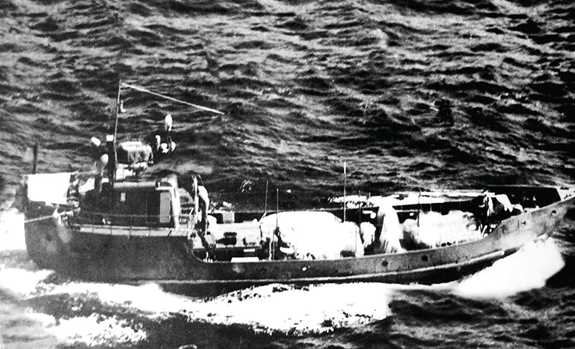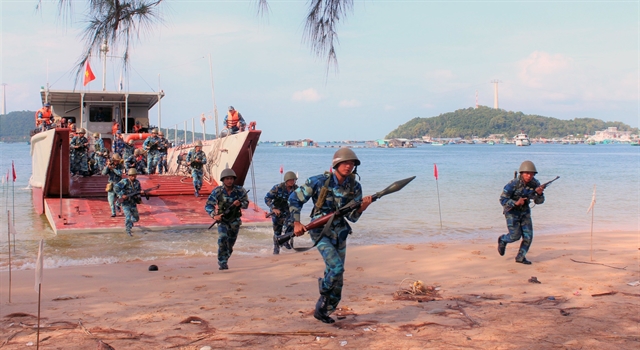
INSPIRATIONAL LEADER: President Nguyễn Xuân Phúc and the delegates at the meeting for the 60th anniversary of Hồ Chí Minh Trail at Sea. VNA/VNS Photo Thống Nhất
Sixty years have passed since the Hồ Chí Minh Trail at sea was established. Across this legendary route, many ships overcame typhoons and strict enemy blockades to successfully transport hundreds of thousands of tonnes of weapons, food and medicines to supply the southern front, contributing to the national great victory in Spring, 1975. Việt Nam News reviews these stunning successes involved.
The feats and brave sacrifices of officers and soldiers serving 'Hồ Chí Minh Trail at Sea' have become immortal, a legend for the next generation to admire, respect and be proud, according to President Nguyễn Xuân Phúc.
The President said while receiving war veterans, who took part in missions along the historical trail, and representatives of the Việt Nam People’s Navy in Hà Nội on October 19. The gathering was to mark the 60th anniversary of the glorious secret sea lane.
The State leader said that the opening of the lane demonstrated the strategic vision, creativity, wisdom and ingenuity of the Party and President Hồ Chi Minh, making an important contribution to improving the nation’s combat capacity and creating a new development step for the Southern revolution.
Phúc said that the sea was not only a living space but also a sacred territory of the nation.
He also emphasized the need to continue to fully protect Việt Nam’s sovereignty over its sea and islands in all situations; maintain an environment of peace and stability at sea for national development; and settle disagreements and disputes by peaceful means in line with the Party and State's policy and stance, and Vietnamese law and international law, especially the 1982 United Nations Convention on the Law of the Sea.
The President said he wished each veteran would continue the tradition of revolutionary heroism, courage, iron will, and relentless efforts to build the country toward prosperity.

NUMBERLESS SHIP: A vessel that helped transport goods on the legendary ocean trail. VNA File Photo
The Hồ Chí Minh Trail at Sea was set up on October 23, 1961 to transport military supplies from the North to aid the southern liberation army.
During the Vietnamese people’s resistance war against the US for national salvation, the Hồ Chí Minh Trail was considered a “strategic road through jungles” while the Hồ Chí Minh Trail at Sea was associated with secret ‘transport ships without numbers’.
To further enhance its capability of timely supporting the south and to aid in liberating the South and reunifying the country, the Political Bureau decided to open a second transport route at sea.
The existence of this mysterious sea route caused extreme difficulties for the US and Sài Gòn forces who tried to prevent the northern army from assisting in southern liberation forces.
On October 23, 1961, the Ministry of Defence decided to establish Mission 759 (now Naval Brigade 125), marking the birth of the 'Hồ Chí Minh Trail at Sea', a strategic transport route.
On the night of October 11, 1962, the first wooden motorboat of Mission 759, disguised as a fishing boat carrying 30 tonnes of weapons, secretly left the Nghiêng Wharf, Hải Phòng port city with a spirit of “speed and daring, all for the sake of the South liberation”.
After 10 days at sea, the ship safely arrived at Vàm Lũng Wharf in the southern cape province of Cà Mau.
After that successful trip, President Hồ Chí Minh sent a telegram to the soldiers of Mission 759 to encourage them. He advised them to draw from their experience to continue transporting weapons to the south so that the people could fight against the enemy, for North-South reunification.
To avoid attention, most of the ships carrying weapons for the southern battlefields were disguised as fishing ships with no registered numbers and they constantly changed their routes.

MILITARY MIGHT: Following the tradition of the Hồ Chí Minh Trail at Sea, Naval Region 5 Command soldiers trained reinforcements for islands. VNA/VNS Photo
By February 1965, the strategic sea lane was no longer a secret. Enemy troops already know the exact methods and means of transport. They intensively increased sea patrols, stepped up bombing to ravage the North and deployed many forces and means to block the reinforcements at sea.
Because of this, Mission 759 had to change its operations, forcing the fleet to use different routes.
Since 1967, implementing the Resolution of the Party Central Committee, together with the Hồ Chí Minh Trail along the Trường Sơn mountain range, officers and soldiers of the Hồ Chí Minh Trail at Sea focused all their efforts on transporting to serve the 1968 Spring General Offensive and Uprising.
Many supplies shipments arrived at liberated areas in the South and South Central, but there were also many officers and soldiers who had ships destroyed and many comrades who sacrificed heroically. Ship 235, piloted by Captain Nguyễn Phan Vinh, fought heroically and destroyed a ship at Hòn Hèo, Khánh Hòa in March 1968.
During the anti-US war, the Hồ Chí Minh Trail at Sea contributed to the great victory in the spring of 1975, completely liberating the South and reunifying the country.
Veteran Nguyễn Đắc Thớ, former chief engineer of Ship 641, was touched when recalling memories on the unnumbered ship.
“I was determined to sacrifice my life every time I set out on a trip. Unlike on land, each officer and soldier when participating in a ship without registered number must face more dangers at the same time. It was the pursuit of the enemy, the great waves, the irregularities of the weather. We carried out the assigned tasks with creativity, ingenuity and courage for the purpose of protecting goods, weapons and ensuring the secrecy of the mission," he said.
The Hồ Chí Minh Trail is a miracle of the nation, a unique and creative feature of the Việt Nam people's war, of the Vietnamese military, and a noble symbol of the will to win independence and reunification for the country. VNS
OVietnam